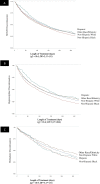Racial and Ethnic Inequities in Buprenorphine and Methadone Utilization Among Reproductive-Age Women with Opioid Use Disorder: an Analysis of Multi-state Medicaid Claims in the USA
- PMID: 37436568
- PMCID: PMC10713957
- DOI: 10.1007/s11606-023-08306-0
Racial and Ethnic Inequities in Buprenorphine and Methadone Utilization Among Reproductive-Age Women with Opioid Use Disorder: an Analysis of Multi-state Medicaid Claims in the USA
Abstract
Background: Associations between race/ethnicity and medications to treat OUD (MOUD), buprenorphine and methadone, in reproductive-age women have not been thoroughly studied in multi-state samples.
Objective: To evaluate racial/ethnic variation in buprenorphine and methadone receipt and retention in a multi-state U.S. sample of Medicaid-enrolled, reproductive-age women with opioid use disorder (OUD) at the beginning of OUD treatment.
Design: Retrospective cohort study.
Subjects: Reproductive-age (18-45 years) women with OUD, in the Merative™ MarketScan® Multi-State Medicaid Database (2011-2016).
Main measures: Differences by race/ethnicity (non-Hispanic White, non-Hispanic Black, Hispanic, "other" race/ethnicity) in the likelihood of receiving buprenorphine and methadone during the start of OUD treatment (yes/no) were estimated using multivariable logistic regression. Differences in time to medication discontinuation (days) by race/ethnicity were evaluated using multivariable Cox regression.
Results: Of 66,550 reproductive-age Medicaid enrollees with OUD (84.1% non-Hispanic White, 5.9% non-Hispanic Black, 1.0% Hispanic, 5.3% "other"), 15,313 (23.0%) received buprenorphine and 6290 (9.5%) methadone. Non-Hispanic Black enrollees were less likely to receive buprenorphine (adjusted odds ratio, aOR = 0.76 [0.68-0.84]) and more likely to be referred to methadone clinics (aOR = 1.78 [1.60-2.00]) compared to non-Hispanic White participants. Across both buprenorphine and methadone in unadjusted analyses, the median discontinuation time for non-Hispanic Black enrollees was 123 days compared to 132 days and 141 days for non-Hispanic White and Hispanic enrollees respectively (χ2 = 10.6; P = .01). In adjusted analyses, non-Hispanic Black enrollees experienced greater discontinuation for buprenorphine and methadone (adjusted hazard ratio, aHR = 1.16 [1.08-1.24] and aHR = 1.16 [1.07-1.30] respectively) compared to non-Hispanic White peers. We did not observe differences in buprenorphine or methadone receipt or retention for Hispanic enrollees compared to the non-Hispanic White enrollees.
Conclusions: Our data illustrate inequities between non-Hispanic Black and non-Hispanic White Medicaid enrollees with regard to buprenorphine and methadone utilization in the USA, consistent with literature on the racialized origins of methadone and buprenorphine treatment.
Keywords: addiction medicine; buprenorphine; methadone; opioid use disorder; pregnancy; racial disparities.
© 2023. The Author(s), under exclusive licence to Society of General Internal Medicine.
Conflict of interest statement
All authors report no conflicts of interest. LJB is listed as an inventor on US Patent 8080371, ‘Markers for Addiction’, covering use of SNPs in determining the diagnosis, prognosis and treatment of addiction. All other authors declare no financial interests. All authors do not have any financial or non-financial relationships with organizations that may have an interest in our submitted work.
Figures



Similar articles
-
Assessment of Racial and Ethnic Disparities in the Use of Medication to Treat Opioid Use Disorder Among Pregnant Women in Massachusetts.JAMA Netw Open. 2020 May 1;3(5):e205734. doi: 10.1001/jamanetworkopen.2020.5734. JAMA Netw Open. 2020. PMID: 32453384 Free PMC article.
-
A cross-sectional study of differences in medication for opioid use disorder receipt among pregnant people enrolled in Medicaid in Oregon, United States.Addiction. 2025 May;120(5):997-1006. doi: 10.1111/add.16752. Epub 2025 Jan 10. Addiction. 2025. PMID: 39789947
-
Initiation and Treatment Discontinuation of Medications for Opioid Use Disorder in Pregnant People Compared With Nonpregnant People.Obstet Gynecol. 2023 Apr 1;141(4):845-853. doi: 10.1097/AOG.0000000000005117. Epub 2023 Mar 9. Obstet Gynecol. 2023. PMID: 36897142 Free PMC article.
-
Underrepresentation of diverse populations and clinical characterization in opioid agonist treatment research: A systematic review of the neurocognitive effects of buprenorphine and methadone treatment.J Subst Abuse Treat. 2022 Apr;135:108644. doi: 10.1016/j.jsat.2021.108644. Epub 2021 Oct 23. J Subst Abuse Treat. 2022. PMID: 34857427
-
Effectiveness of and Access to Medications for Opioid Use Disorder for Adolescents and Young Adults: A Scoping Review.J Addict Med. 2022 May-Jun 01;16(3):e157-e164. doi: 10.1097/ADM.0000000000000898. J Addict Med. 2022. PMID: 34282085 Free PMC article.
Cited by
-
Prescription psychostimulant use, admissions and treatment initiation and retention in pregnant people with opioid use disorder.Nat Ment Health. 2024 Jul;2(7):801-808. doi: 10.1038/s44220-024-00270-w. Epub 2024 Jun 11. Nat Ment Health. 2024. PMID: 39726823 Free PMC article.
-
Multilevel Factors Impacting Substance Use Treatment Access, Engagement, and Racial Equity Among Opioid Overdose Survivors in Boston, MA.J Gen Intern Med. 2024 Oct;39(13):2390-2399. doi: 10.1007/s11606-024-08918-0. Epub 2024 Jul 12. J Gen Intern Med. 2024. PMID: 38997532
-
The intersection of substance use stigma and anti-Black racial stigma: A scoping review.Int J Drug Policy. 2024 Nov;133:104612. doi: 10.1016/j.drugpo.2024.104612. Epub 2024 Oct 5. Int J Drug Policy. 2024. PMID: 39369573
-
Maternal Area of Residence and Outcomes for Mother-Infant Dyads with Perinatal Opioid Exposure.Am J Perinatol. 2025 Jun 16:10.1055/a-2622-3839. doi: 10.1055/a-2622-3839. Online ahead of print. Am J Perinatol. 2025. PMID: 40436395 Free PMC article.
-
County-level neonatal opioid withdrawal syndrome rates and real-world access to buprenorphine during pregnancy: An audit ("secret shopper") study in Missouri.Drug Alcohol Depend Rep. 2024 Feb 2;10:100218. doi: 10.1016/j.dadr.2024.100218. eCollection 2024 Mar. Drug Alcohol Depend Rep. 2024. PMID: 38380272 Free PMC article.
References
MeSH terms
Substances
Grants and funding
LinkOut - more resources
Full Text Sources
Medical

